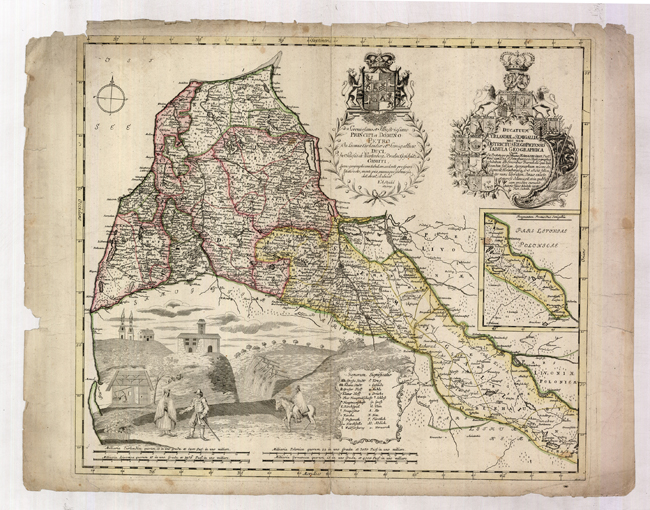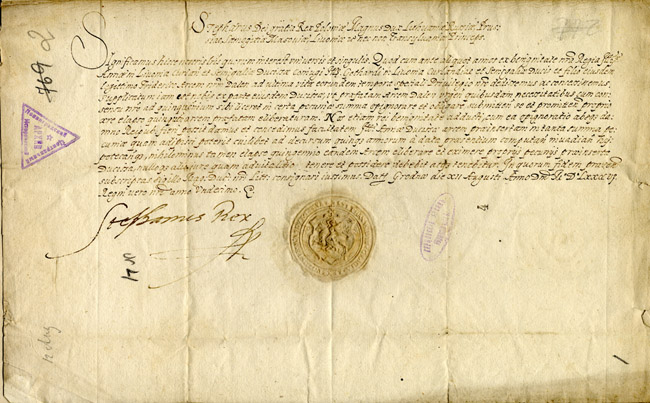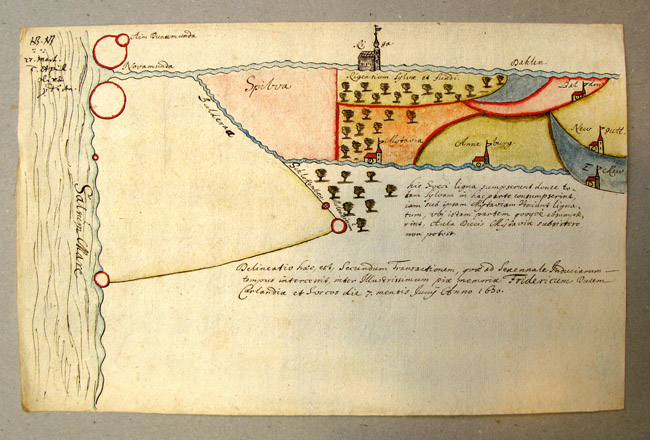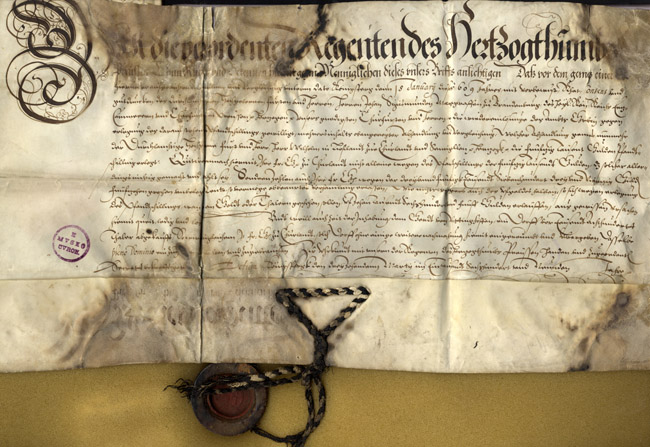The Territory of the Duchy
In accordance with the Pacta Subiectionis, Gotthard Kettler received as a heritable fief the lands formerly ruled by the order in Courland and Semigallia. At that time, the duchy did not include the Castellany of Grobin/Grobiņa, which had been mortgaged to the Duke of Prussia and was regained by Duke William in 1609, or Ocknist/Aknīste-Manor, which the King of Poland had granted to the Lithuanian Kroschinsky. The former Bishopric of Couronia, or Pilten/Piltene District, consisting of three isolated areas, continued to exist as a separate territory. Right from the beginning, the dukes had to defend their state from the encroachments of neighbours. In the south, the Lithuanians strove to make gains at the expense of the duchy, in many cases taking by force lands that belonged to subjects of the duke. Conflicts along the Lithuanian border continued even after regulation of the border in 1680 and went on right up to the abolition of the duchy. In the north, the border between the duchy and possessions of the King of Poland followed the middle of the River Düna/Daugava, but along the lower course of the river the situation was more complicated. On the left bank of the Düna/Daugava, i.e. on the bank belonging to the duchy, there was part of the Bailiwick of Riga, within which there were properties belonging to the duke, for example half of the Spilwe/ Spilve Meadows. The duke also had the area of present-day Daugavgrīva. As a result of the Polish-Swedish War (16001629) the Duchy of Courland had a new neighbour: Sweden. In 1630 the Swedes forced Duke Frederick to conclude a special border agreement, giving them several areas that had previously belonged to the duchy: Dahlen/Dole, Pulkarn/Pulkarne, Bersemünde/ Bērzmente, Spilwe/Spilve and Dünamünde/Daugavgrīva.
1. Map of the Duchy of Courland and Semigallia. 1770. LVVA, Collection 6828, Inventory 2, File 208.
The Pilten District is marked in green within Courland, as is the Bailiwick of Riga, next to the city. The map is not very precise.
2. Confirmation by Stephen Bathory, King of Poland-Lithuania, to Duchess Anna of her right to Dahlen/Dole. Grodno, 12 August 1586. Parchment. LVVA, Collection 554, Inventory 1, File 26, Volume XIV.
The King of Poland had granted the island and castle of Dahlen/Dole to Duchess Anna already in 1585. This was officially confirmed the following year. Later, Dahlen/Dole passed to Duke Frederick, who in 1617 gave it to his wife Elisabeth Magdalena. In 1621 Dahlen/Dole was taken by the Swedish army. All attempts by the dukes to regain Dahlen/Dole ended in failure.
3. Sketch of the border between the Duchy of Courland and the Swedish possessions in 1630. National Archives of Sweden, Stockholm.
Under the agreement of June 1630, the western part of the border between Courland and Sweden was to pass between Kaugern/Kauguri and Schlock/Sloka, as shown in the sketch, but in reality the border was much closer to Dünamünde/Daugavgrīva, so that the Swedes had Bullen/Buļļi-Manor and the Duke had Buldernhof/Bulduri. In the area claimed by the Swedes they were permitted to cut timber for the new-established fort at Dünamünde/ Daugavgrīva. Sweden was forced to relinquish this right in 1660.
4. Confirmation by the government of the Duchy of Prussia that Duke William had repaid the loan of 50 000 guilders on the Castellany of Grobin/Grobiņa. Königsberg, 13 March 1609. Parchment. LVVA, Collection 5561, Inventory 4, File 775.
Even though the marriage agreement concluded in 1609 between Duke William and Sophie, Princess of Prussia, does not mention Grobin/Grobiņa, it is considered that this district, which had been mortgaged to Prussia in 1560, was received by William as a gift from his father-in-law. The document issued to William affirmed the title of the Dukes of Courland to this territory in the event of future claims by Prussia.




